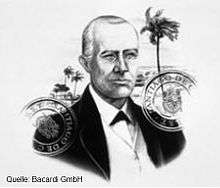Facundo Bacardi
| Facundo Bacardi | |
|---|---|
 Facundo Bacardí | |
| Born |
1814 Sitges, Barcelona, Spain |
| Died |
9 May 1886 Santiago de Cuba, Spanish Cuba |
Don Facundo Bacardí Masso (Catalan: Facund Bacardí i Massó, IPA: [fəˈkund bəkərˈði j məˈso]) (1814 – May 9, 1886) was a Spanish businessman. In 1862 he founded the eponymous Bacardi rum distillery.
Biography
Bacardí was born in Sitges (province of Barcelona, in Spain), son of a family of bricklayers. He followed his older brothers to Cuba, finding employment in their general store in Santiago. Over time, he saved up his own capital, and in 1844 he established his own mercantile shop.
Just three months earlier he had married Amalia Moreau, a woman from a very prosperous family of Franco-Haitian descent.[1][2][3] Both would prove to be sources of capital for Facundo's business ventures. Facundo and Amalia went on to have a number of children, many of whom would play important parts in building the rum business for which the family became famous: Emilio was born in 1844, Juan in 1846, Facundo Jr. in 1848, María in 1851, José in 1857, and Amalia Jr. in 1861.
An earthquake followed by a cholera epidemic devastated Santiago in 1852, claiming Juan and María and sending Facundo and his family to Catalonia for a number of months to escape. Upon his return, Facundo found his store looted and business conditions in Santiago poor in the wake of the disaster and amid a global slump in sugar, the mainstay of the economy. Facundo's business wasn't able to recover, and it was bankrupt in 1855.
Soon after, Facundo began to experiment with the process of distilling rum. Previously, rum was a crude, low quality beverage. Facundo, with the help of a French Cuban named José León Boutellier, a tenant of Clara Astie, began to experiment with methods of distillation. Exactly what techniques they developed are debated, but some combination of quicker-fermenting cognac yeast, charcol filtration, white oak barrel aging, and painful trial-and-error based adjustments of distillation and fermentation resulted in much more refined, tamer drink which they successfully sold through Facundo's brother's general store.
In 1862 the partners acquired a distillery and constituted the firm "Bacardí, Boutellier, and Company", using capital supplied by Facundo's younger brother José. Having started in retailing, Bacardi understood how to sell things, and realized that his innovative drink would benefit from good branding. He began to sign each shipment of rum with a bold "Bacardí M" (for Bacardi Massó); in addition, he used the now iconic bat as the brand's image.[4]
In 1874, the firm was reorganized. Facundo bought out his younger brother José, and his sons contributed some of their own capital and bought out most of Boutellier's stake as he declined in health. The new company was named simply "Bacardí and Company". The firm gained growing renown as its rum was sold throughout Cuba and even the wider world after winning prizes in international exhibitions. In 1877 Facundo retired, turning management of the company over to his sons Emilio (president) Facundo Jr. (master blender), and José (sales).
The ensuing period of Cuban history was politically tumultuous, as the society struggled against Spanish imperialism. Facundo was generally pro-Spanish,[4] which partially restrained the liberal tendencies of his respectful sons. However, Emilio in particular became highly involved in nationalistic politics while running the business and became suspected by the authorities. During one of many sweeps by the loyalist security services, Emilio and Facundo himself were arrested. Facundo was released but Emilio was eventually imprisoned for four years, during which the business was operated by the remaining brothers with Facundo providing strategic advice from the prison.
Facundo lived to see Emilio released and the business to grow in fame, although not yet in financial strength.
References
- ↑ Miranda, Miguel Bonera (2000). "Oro blanco: una historia empresarial del ron cubano". Lugus. p. 75. Retrieved 31 March 2017.
- ↑ Padura, Leonardo. "Siempre la memoria, mejor que el olvido: Entrevistas, crónicas y reportajes selectos". Verbum Editorial. p. 34. Retrieved 31 March 2017.
- ↑ Press (1988). "Cuba internacional, Issues 223-228". Agencia Prensa Latina. p. 263. Retrieved 31 March 2017.
- 1 2 Gjelten, Tom (2008). Bacardi and the Long Fight for Cuba. Viking. p. 23, 35.